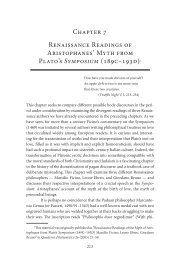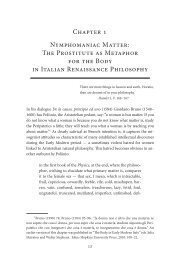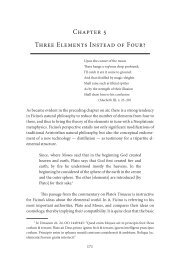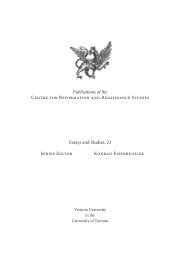Chapter 2 Matter as a Mirror: Marsilio Ficino and Renaissance ...
Chapter 2 Matter as a Mirror: Marsilio Ficino and Renaissance ...
Chapter 2 Matter as a Mirror: Marsilio Ficino and Renaissance ...
You also want an ePaper? Increase the reach of your titles
YUMPU automatically turns print PDFs into web optimized ePapers that Google loves.
<strong>Matter</strong> <strong>as</strong> a <strong>Mirror</strong> 77<br />
category of reflection, that is, a reflection that never met a mirror is, however,<br />
Aristotelian in origin. 96 Plutarch maintains that all creative acts include the<br />
distortion of the original form that is imprinted on matter; just <strong>as</strong> mirrors<br />
render side-inverted images, any other material adds a difference, <strong>and</strong> thereby<br />
contaminates the original.<br />
For pure design cannot be seen by us, <strong>and</strong> when it is made<br />
manifest in another guise <strong>and</strong> through another medium, it<br />
becomes contaminated with the nature of this medium. Wax,<br />
for example, <strong>and</strong> gold <strong>and</strong> silver I leave out of account <strong>as</strong> well<br />
<strong>as</strong> other kinds of material, which, when moulded, take on the<br />
particular form of the likeness which is being modelled; <strong>and</strong> yet<br />
each one of them adds to the thing portrayed a distinguishing<br />
characteristic which comes from its own substance; <strong>and</strong> so<br />
also the numberless distortions seen in mirrors both plane <strong>and</strong><br />
concave <strong>and</strong> convex. 97<br />
The confusion between mirror reflection, shadow, <strong>and</strong> imprint<br />
structures the entire complex of ide<strong>as</strong> involved in the notion of a creative<br />
<strong>and</strong> Narcissistic look at matter. The gaze, a kind of emission, <strong>as</strong> will soon<br />
become clearer, h<strong>as</strong> the power to shape <strong>and</strong> to act upon the world; conversely,<br />
a shadow still carries <strong>and</strong> embodies the powers, the virtues, of the object it<br />
represents — much to the detriment of Narcissus who is killed by his own<br />
beautiful image, the product of a deceptive mirror.<br />
<strong>Ficino</strong>’s metaphorical use of mirrors is not restricted to his Theologia<br />
platonica or to the Philebus commentary. In his earlier work on the Symposium,<br />
he used specula in a similar context where the divine order is propagated<br />
96 Aristotle, De anima 419B; Frontisi-Ducroux (1997) 171; Guidorizzi (1992) 37, with<br />
references.<br />
97 Plutarch (1927–1969) 404 C-D: vol. V: 314–315; Frontisi-Ducroux (1997) 161.<br />
For a parallel citation in <strong>Ficino</strong>, which does not however mention mirrors, see De amore<br />
II 4: 151: “Sequenti enim gradus post animum forme corporum disponitur. Quorum<br />
nihil sufficienter se habet. Forme huiusmodi neque sufficienter sunt, neque sufficienter<br />
nobis divina ostendunt. Verae namque res, ideae, rationes et semina sunt. Corporum<br />
vero formae umbrae rerum potius quam verae res esse videntur. Quemadmodum vero<br />
corporis umbra exactam atque distinctam corporis figuram non indicat, ita corpora divinorum<br />
naturam propriam non demonstrat. Circa ipsum regem et ea quae dixi nihil est<br />
tale. Quo enim pacto mortalia immortalibus et falsa veris similia sint?”







